Study of Aircraft Icing Forecasting Methods and Their Application Scenarios over Eastern China
Abstract
1. Introduction
2. Data and Methods
2.1. Icing Accumulation Data
2.2. Icing Accumulation Diagnosis Algorithms
- (1)
- IC index method
- (2)
- TF empirical method
3. Testing of Icing Accumulation Diagnosis Algorithms
4. Analysis of an Icing Accumulation Process
5. Research on Application Scenarios of Icing Accumulation Prediction Algorithms
5.1. Analysis of Pressure Levels Prone to Icing Accumulation
5.2. Analysis of Time Period Prone to Icing Accumulation
6. Conclusions and Discussion
- (1)
- The IC index method and the TF empirical method are evaluated using 25 cases of icing accumulation reported by aircraft. The results shows that the diagnostic prediction accuracy of the IC index method is 80%, and the accuracy of the TF empirical method for diagnosis and prediction is 92%. Both the IC index method and the TF empirical method can effectively diagnose the icing accumulation area and the intensity of icing accumulation. The prediction accuracy of the two methods is higher for icing accumulation at low levels (below 5000 m) but lower when predicting icing accumulation at high levels (above 5000 m). For the icing accumulation intensity, the accuracy predicted by the TF empirical method is higher than that of the IC index method mainly because the TF empirical method takes the ice water particles concentration and cloud cover in medium and low clouds into account, while the IC index method depends only on the air temperature and relative humidity. However, the TF empirical method is prone to false reports at high pressure levels, which is possibly due to the fact that the calculated airspeed is not the actual airspeed.
- (2)
- In practical application scenarios, both the IC index method and the TF empirical method not only better capture the pressure levels where icing accumulation is prone to occur, but also accurately predict the distribution of icing accumulation intensity at high pressure levels in the stations. However, there is a significant difference between the IC index method and the TF empirical method in analyzing icing accumulation-prone time periods, which may be related to the assumed airspeed conditions.
Author Contributions
Funding
Data Availability Statement
Acknowledgments
Conflicts of Interest
References
- Li, H.R.; Zhang, Y.F.; Chen, H.X. Optimization design of airfoils under atmospheric icing conditions for UAV. Chin. J. Aeronaut. 2022, 35, 118–133. [Google Scholar] [CrossRef]
- Wu, Q.; Xu, H.J.; Pei, B.B.; Wei, Y. Conceptual design and preliminary experiment of icing risk management and protection system. Chin. J. Aeronaut. 2022, 35, 101–115. [Google Scholar] [CrossRef]
- Cao, Y.H.; Tan, W.Y.; Wu, Z.L. Aircraft icing: An ongoing threat to aviation safety. Aerosp. Sci. Technol. 2018, 75, 353–385. [Google Scholar] [CrossRef]
- Wang, Q.; Wu, J.J. Analysis of weather conditions for aircraft icing in low-level flight in Sichuan Basin. Meteor. Sci. Technol. 2018, 46, 799–808. (In Chinese) [Google Scholar] [CrossRef]
- He, X.D.; Liu, Y.S.; Gou, W.X.; Zhang, F. An aircraft icing forecasting method based on cloud microphysical parameters. Aeronaut. Comput. Tech. 2012, 24, 72–75+79. (In Chinese) [Google Scholar] [CrossRef]
- Xu, W.S. Analysis of Meteorological Conditions of Aircraft Icing Events at the Diwopu Airport in Urumqi and Their Case Simulations. Master’s Thesis, Nanjing University of Information Science and Technology, Nanjing, China, 2020. (In Chinese). [Google Scholar]
- Schultz, P.; Politovich, M.K. Toward the improvement of aircraft-icing forecasts for the Continental United States. Weather Forecast. 1992, 7, 491–500. [Google Scholar] [CrossRef]
- Carrière, J.M.; Alquier, S.; Le Bot, C.; Moulin, E. Statistical verification of forecast icing risk indices. Meteor. Appl. 1997, 4, 115–130. [Google Scholar] [CrossRef]
- Thompson, G.; Bruintjes, R.T.; Brown, B.G.; Hage, F. Intercomparison of in-flight icing algorithms. Part I: WISP94 real-time icing prediction and evaluation program. Weather Forecast. 1997, 12, 878–889. [Google Scholar] [CrossRef]
- Zhang, F.; Huang, Z.; Yao, H.J.; Zhai, W.H.; Gao, T.F. Icing severity forecast algorithm under both subjective and objective parameters uncertainties. Atmos. Environ. 2016, 128, 263–267. [Google Scholar] [CrossRef]
- Bian, S.S.; He, H.R.; An, H.; Pan, X.B.; Zhang, Y. Comparison of Aircraft Ice Accumulation Prediction Algorithms and Research on Integrated Prediction Model. Meteor. Mon. 2019, 45, 1352–1362. (In Chinese) [Google Scholar] [CrossRef]
- Bernstein, B.C.; Mcdonough, F.; Poliovich, M.K.; Brown, B.G.; Ratvasky, T.P.; Miller, D.R.; Wolff, C.A.; Cunning, G. Current icing potential: Algorithm description and comparison with aircraft observations. J. Appl. Meteor. Climatol. 2005, 44, 969–986. [Google Scholar] [CrossRef]
- Smith, W.L.; Minnis, P.; Fleeger, C.; Spangenberg, D.; Palikonda, R.; Nguyen, L. Determining the flight icing threat to aircraft with single-layer cloud parameters derived from operational satellite data. J. Appl. Meteor. Climatol. 2012, 51, 1794–1810. [Google Scholar] [CrossRef]
- Bernstein, B.C.; Wolff, C.A.; Mcdonough, F. An inferred climatology of icing conditions aloft, including supercooled large drops. Part I: Canada and the continental United States. J. Appl. Meteor. Climatol. 2007, 46, 1857–1878. [Google Scholar] [CrossRef]
- Liu, F.L.; Sun, L.T.; Li, S.J. Study on methods of aircraft icing diagnosis and forecast. Meteor. Environ. Sci. 2011, 34, 26–30. (In Chinese) [Google Scholar] [CrossRef]
- Zhao, Y.; Fu, Y.; Zhao, Z.L.; Sun, X.J.; Han, Z.G.; Yao, Z.G. Satellite data based statistical study of the characteristics of potential distribution of global aircraft icing. J. Trop. Meteor. 2018, 34, 102–114. (In Chinese) [Google Scholar] [CrossRef]
- Qi, C.; Jin, C.X.; Guo, W.L.; Gan, L.; Zhao, D.L.; Lu, J.; Wu, S.; Li, H.P. Icing potential index of aircraft icing based on fuzzy logic. J. Appl. Meteor. Sci. 2019, 30, 619–628. (In Chinese) [Google Scholar] [CrossRef]
- Stith, J.L.; Dye, J.E.; Bansemer, A.; Heymsfield, A.J.; Grainger, C.A.; Petersen, W.A.; Cifelli, R. Micro-physical observations of tropical clouds. J. Appl. Meteor. Climatol. 2002, 41, 97–117. [Google Scholar] [CrossRef]
- Fairall, C.W.; Bradley, E.F.; Hare, J.E.; Grachev, A.A.; Edson, J.B. Bulk parameterization of air-sea fluxes: Updates and verification for the COARE algorithm. J. Clim. 2003, 16, 571–591. [Google Scholar] [CrossRef]
- Morrison, H.; Thompson, G.; Tatarskii, V. Impact of cloud microphysics on the development of trailing stratiform precipitation in a simulated squall line: Comparison of one and two-moment schemes. Mon. Weather Rev. 2009, 137, 991–1007. [Google Scholar] [CrossRef]
- Jones, S.L. Simulation of Meteorological Fields for Icing Applications at the Summit of Mount Washington. Master’s Thesis, University of Nebraska Lincoln, Lincoln, NE, USA, 2014. [Google Scholar]
- Lawson, P.; Gurganus, C.; Woods, S. Aircraft Observations of Cumulus Microphysics Ranging from the Tropics to Mid-latitudes: Implications for a “New” Secondary Ice Process. J. Atmos. Sci. 2017, 74, 2899–2920. [Google Scholar] [CrossRef]
- Sergio, F.G.; Jose, L.S.; Estibaliz, G.; López, L.; García-Ortega, E.; Merino, A. Weather Features Associated with Aircraft Icing Conditions: A Case Study. Sci. World J. 2014, 2014, 279063. [Google Scholar] [CrossRef]
- Merino, A.; Garcia, O.E.; Sergio, F.G.; Díaz-Fernández, J.; Quitián-Hernández, L.; Martín, M.L.; López, L.; Marcos, J.L.; Valero, F.; Sánchez, J.L. Aircraft Icing: In-Cloud Measurements and Sensitivity to Physical Parameterizations. Geophys. Res. Lett. 2019, 46, 11559–11567. [Google Scholar] [CrossRef]
- Tetens, O. Uber einige meteorologische Begriffe. Z. Geophys. 1930, 6, 297–309. [Google Scholar]
- Brown, B.G.; Thompson, G.; Bruintjes, R.T.; Bullock, R.; Kane, T. Intercomparison of in-flight icing algorithms. Part II: Statistical verification results. Weather Forecast. 1997, 12, 890–914. [Google Scholar] [CrossRef]
- Yuan, M.; Duan, L.; Ping, F.; Wu, J.J. Identifying the supercooled liquid water in aircraft icing condition using CloudSat satellite data. Meteor. Mon. 2017, 43, 206–212. (In Chinese) [Google Scholar] [CrossRef]
- Liu, X.M.; Zhang, M.J.; Wang, S.J.; Zhao, P.P.; Wang, J.; Zhou, P.P. Estimation and analysis of precipitation cloud base height in China. Meteor. Mon. 2016, 42, 1135–1145. (In Chinese) [Google Scholar] [CrossRef]
- Zhu, S.C.; Guo, X.L. Ice crystal habits, distribution and growth process in stratiform clouds with embedded convection in North China: Aircraft measurements. Acta Meteor. Sin. 2014, 72, 366–389. (In Chinese) [Google Scholar] [CrossRef]
- Cai, Z.X.; Cai, M.; Li, P.R.; Li, J.X.; Sun, H.C.; Gu, Y.; Gao, X. Aircraft observation research on macro and microphysics characteristics of continental cumulus cloud at different development stages. Chin. J. Atmos. Sci. 2019, 43, 1191–1203. (In Chinese) [Google Scholar] [CrossRef]
- Liu, X.E.; Gao, Q.; He, H.; Ma, X.C.; Bi, K.; Zhao, D.L.; Zhou, W. Analysis of aircraft observation data and numerical simulation of vertical structure and precipitation mechanism of stratiform clouds with embedded convections. Acta Meteor. Sin. 2020, 78, 277–288. (In Chinese) [Google Scholar] [CrossRef]
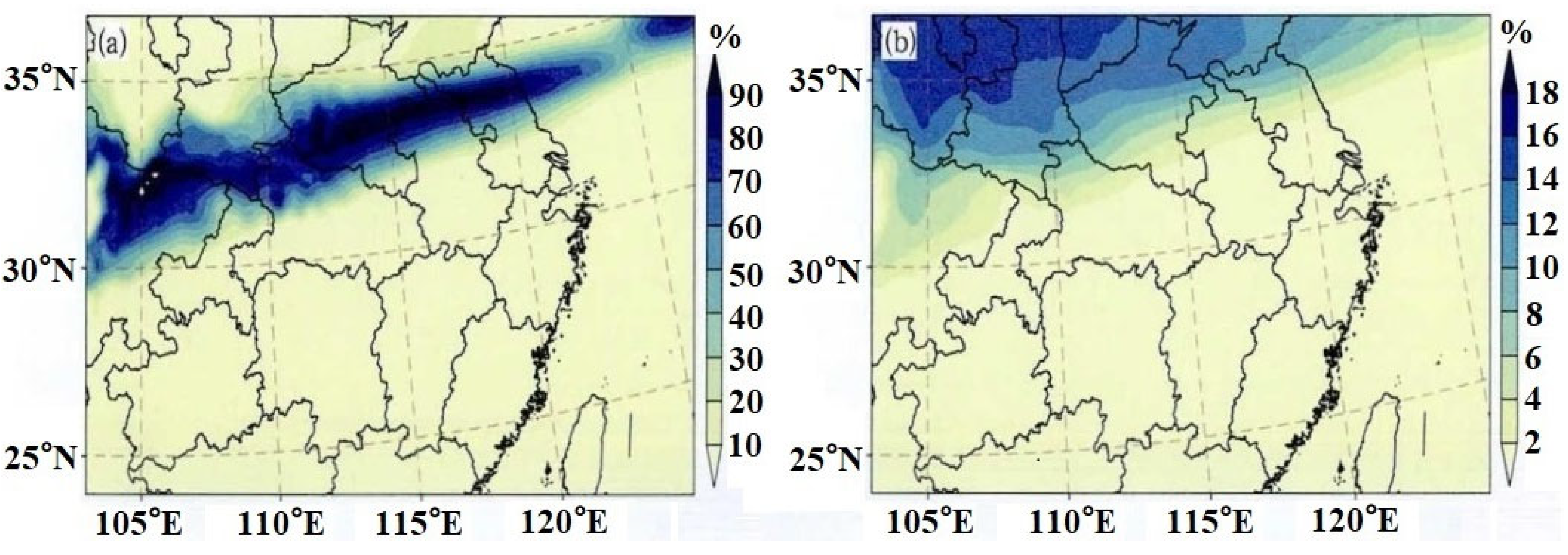
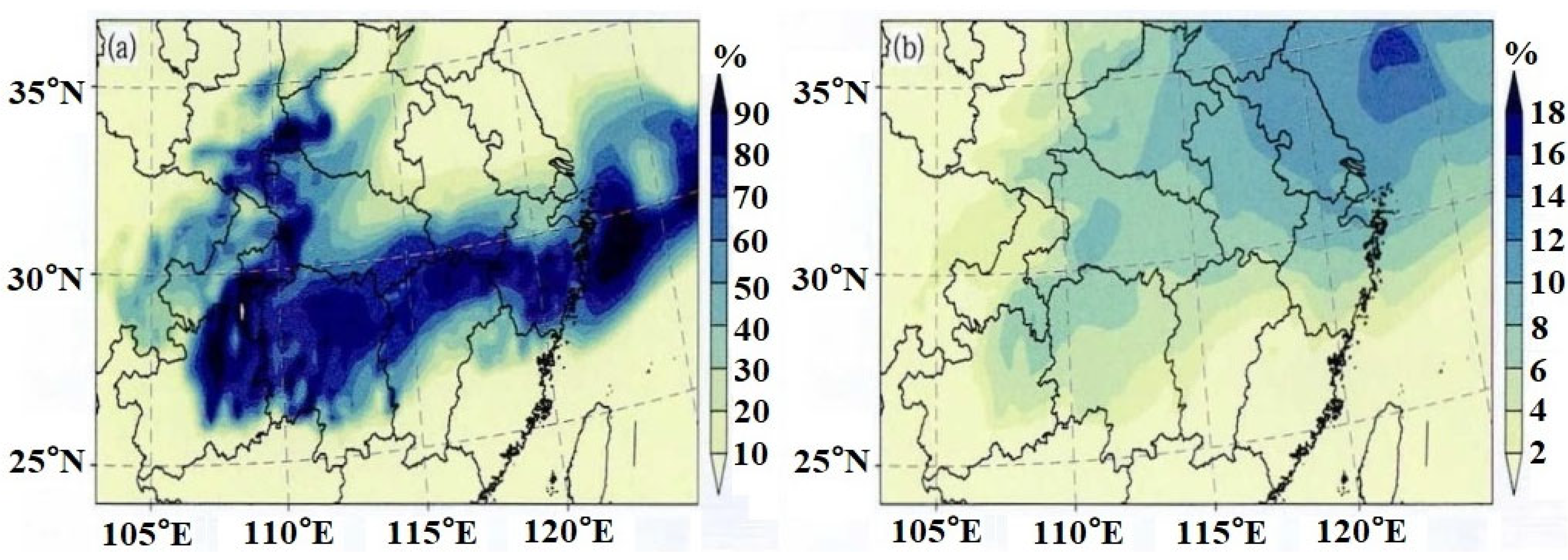
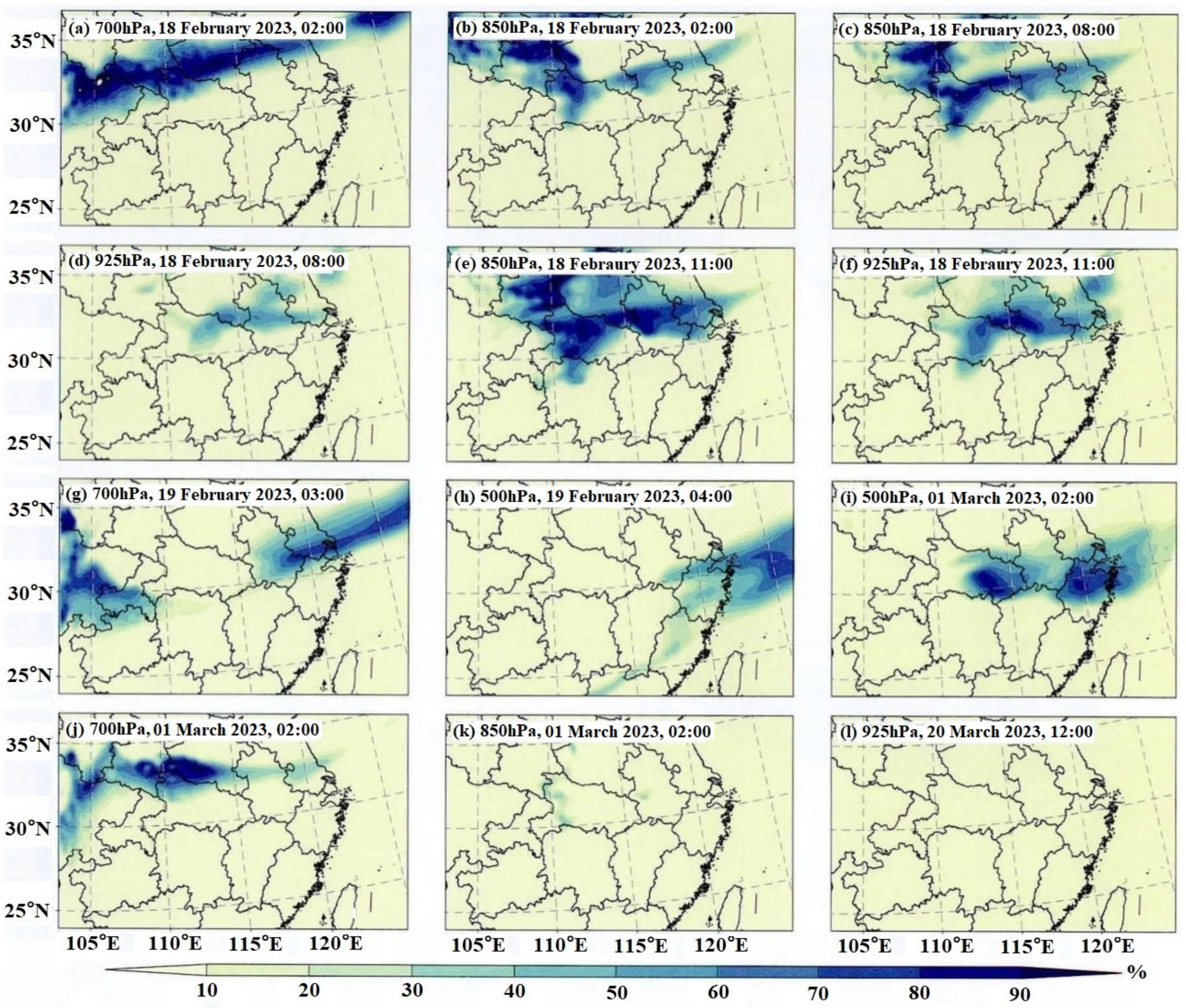
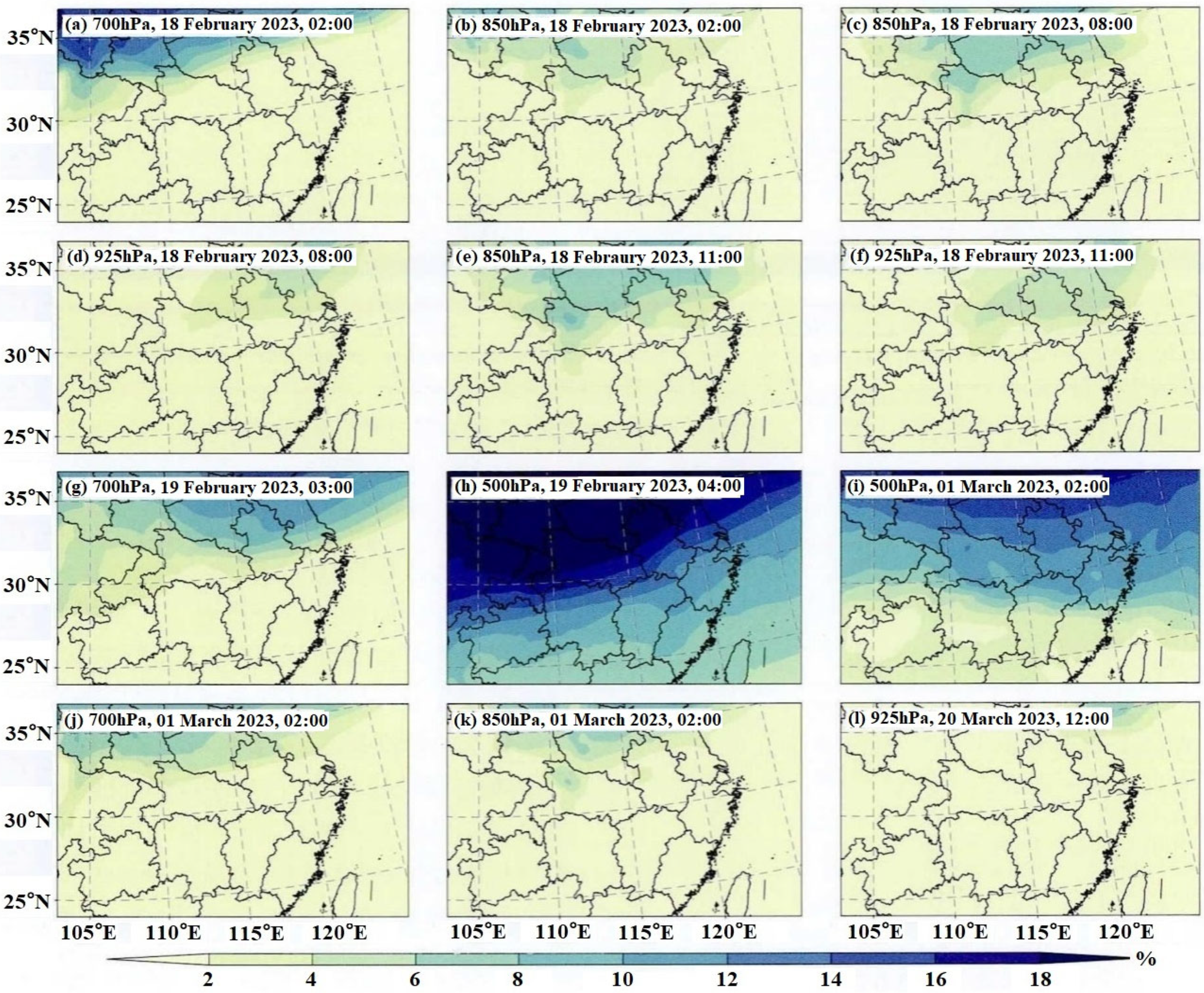

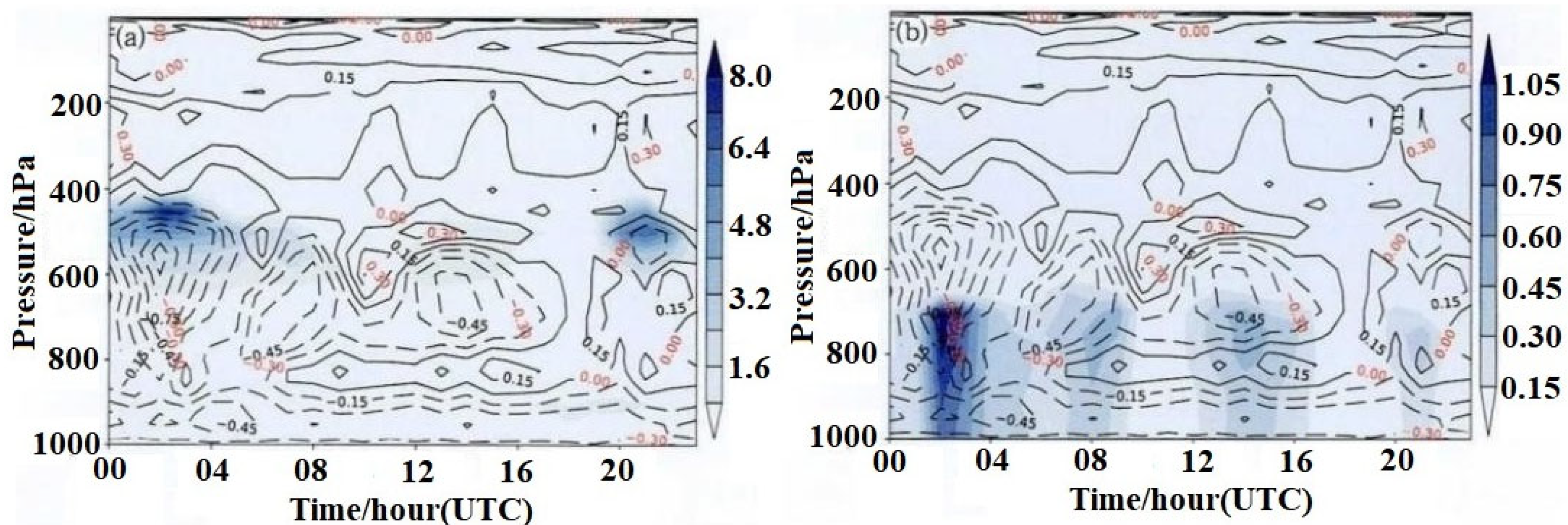
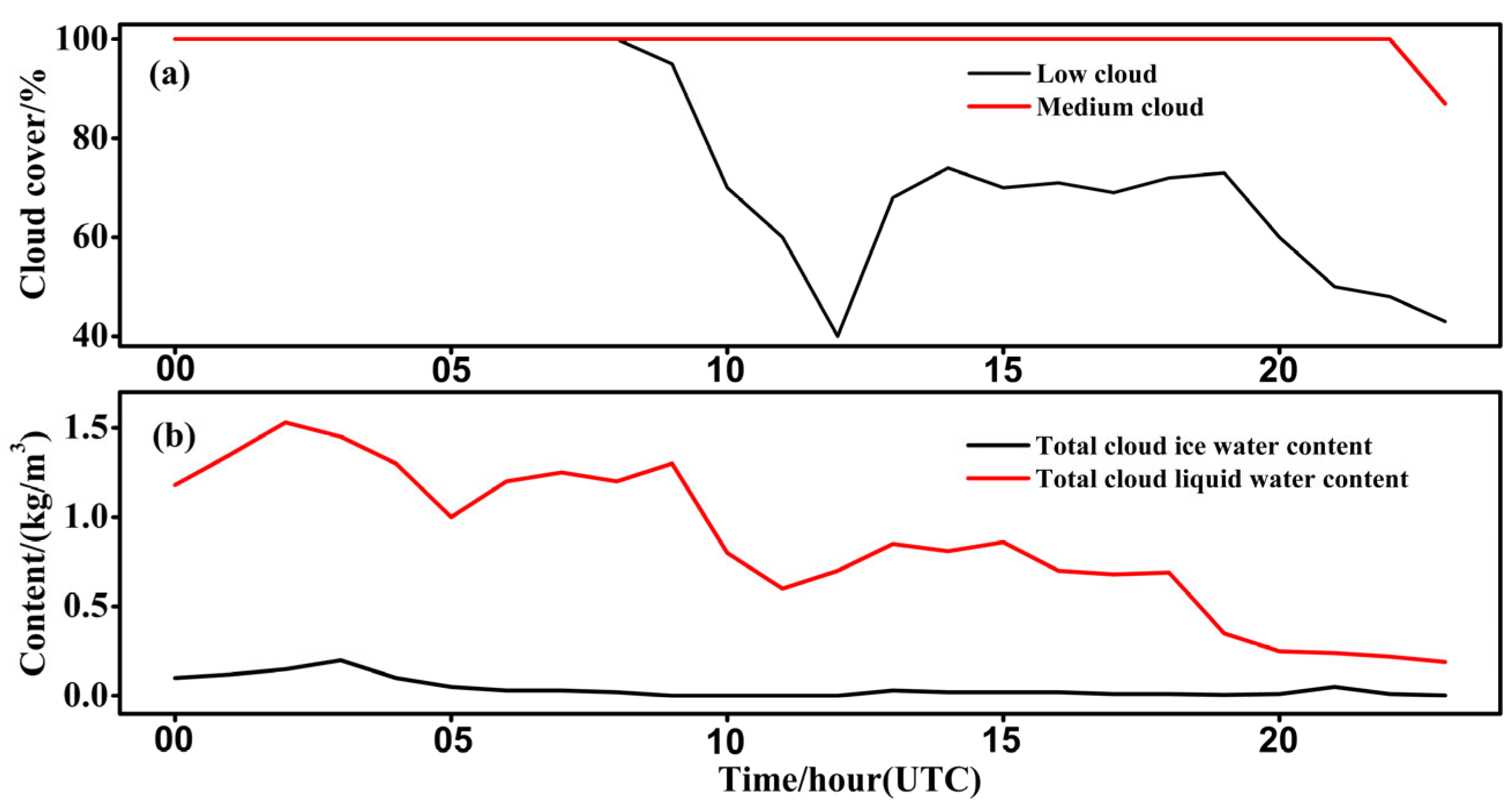
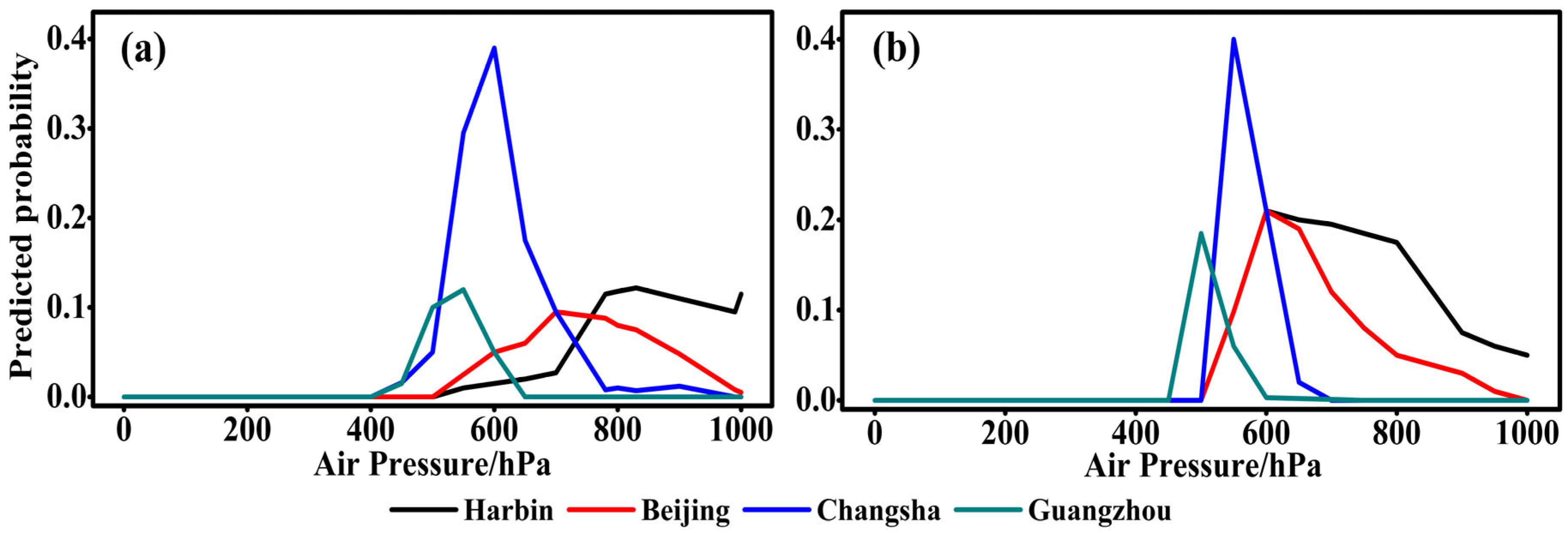
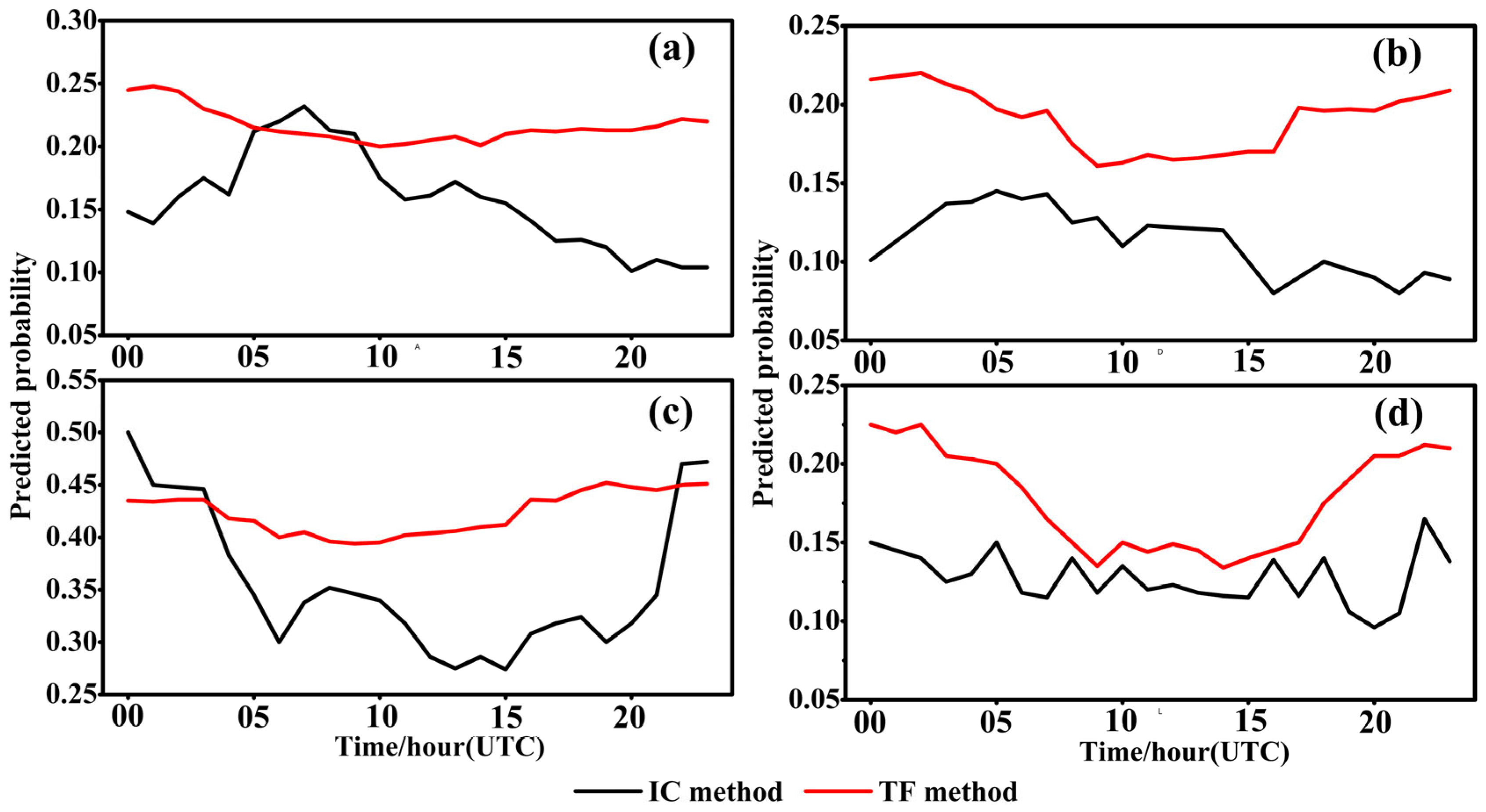
| IC Index (%) | <0 | 0 ≤ IC ≤ 50 | 50 ≤ IC ≤ 80 | IC ≥ 80 |
|---|---|---|---|---|
| Icing intensity | No icing | Light icing | Moderate icing | Severe icing |
| Tfi Index | > 0 | ||
|---|---|---|---|
| Icing intensity | No icing | Icing | Moderate or severe icing |
| Series Number | Time/UTC (Day Month Year, Hour: Minute) | Aircraft Type | Inspection Height/Pressure Level (Unit: m/hPa) | Aircraft Report | IC Index Method | TF Empirical Method |
|---|---|---|---|---|---|---|
| 1 | 06 February 2023, 00:00 | Yun 8 | 800/925 | Light icing | Moderate icing | Light icing |
| 2 | 06 February 2023, 01:00 | B737 | 800/925 | Light icing | Light icing | Light icing |
| 3 | 07 February 2023, 00:00 | B737 | 800/925 | Light icing | Severe icing | Severe icing |
| 4 | 07 February 2023, 11:00 | B737 | 800/925 | Light icing | Moderate icing | Moderate icing |
| 5 | 08 February 2023, 02:00 | B737 | 3000/700 | Light icing | Light icing | Light icing |
| 6 | 08 February 2023, 02:00 | B737 | 5500/500 | Light icing | No icing | Moderate icing |
| 7 | 08 February 2023, 09:00 | B737 | 3000/700 | Light icing | Light icing | Light icing |
| 8 | 08 February 2023, 09:00 | B737 | 1500/850 | Light icing | Light icing | Light icing |
| 9 | 08 February 2023, 09:00 | B737 | 800/925 | Light icing | Moderate icing | Moderate icing |
| 10 | 18 February 2023, 02:00 | B737 | 7000/400 | Light icing | No icing | Severe icing |
| 11 | 18 February 2023, 02:00 | B737 | 9000/300 | No icing | No icing | Severe icing |
| 12 | 18 February 2023, 02:00 | B737 | 3000/700 | No icing | No icing | No icing |
| 13 | 18 February 2023, 02:00 | B737 | 1500/850 | No icing | No icing | No icing |
| 14 | 18 February 2023, 08:00 | B737 | 1500/850 | Light icing | Light icing | Light icing |
| 15 | 18 February 2023, 08:00 | B737 | 800/925 | Light icing | No icing | Light icing |
| 16 | 18 February 2023, 11:00 | B737 | 1500/850 | Light icing | Light icing | Light icing |
| 17 | 18 February 2023, 11:00 | B737 | 800/925 | Light icing | Light icing | Light icing |
| 18 | 19 February 2023, 03:00 | B737 | 3000/700 | Light icing | Light icing | Light icing |
| 19 | 19 February 2023, 04:00 | B737 | 5500/500 | No icing | No icing | Moderate icing |
| 20 | 01 March 2023, 02:00 | A320 | 5500/500 | No icing | No icing | No icing |
| 21 | 01 March 2023, 02:00 | A320 | 3000/700 | Light icing | Light icing | Light icing |
| 22 | 01 March 2023, 02:00 | A320 | 1500/850 | Light icing | No icing | Light icing |
| 23 | 20 March 2023, 12:00 | Yi 76 | 800/925 | Light icing | Light icing | Light icing |
| 24 | 28 March 2023, 02:00 | Yun 8 | 5500/500 | Light icing | No icing | Light icing |
| 25 | 28 March 2023, 02:00 | Yun 8 | 3000/700 | No icing | No icing | No icing |
Disclaimer/Publisher’s Note: The statements, opinions and data contained in all publications are solely those of the individual author(s) and contributor(s) and not of MDPI and/or the editor(s). MDPI and/or the editor(s) disclaim responsibility for any injury to people or property resulting from any ideas, methods, instructions or products referred to in the content. |
© 2025 by the authors. Licensee MDPI, Basel, Switzerland. This article is an open access article distributed under the terms and conditions of the Creative Commons Attribution (CC BY) license (https://creativecommons.org/licenses/by/4.0/).
Share and Cite
Lu, S.; Yang, C.; Shi, W. Study of Aircraft Icing Forecasting Methods and Their Application Scenarios over Eastern China. Forecasting 2025, 7, 53. https://doi.org/10.3390/forecast7030053
Lu S, Yang C, Shi W. Study of Aircraft Icing Forecasting Methods and Their Application Scenarios over Eastern China. Forecasting. 2025; 7(3):53. https://doi.org/10.3390/forecast7030053
Chicago/Turabian StyleLu, Sha, Chen Yang, and Weixuan Shi. 2025. "Study of Aircraft Icing Forecasting Methods and Their Application Scenarios over Eastern China" Forecasting 7, no. 3: 53. https://doi.org/10.3390/forecast7030053
APA StyleLu, S., Yang, C., & Shi, W. (2025). Study of Aircraft Icing Forecasting Methods and Their Application Scenarios over Eastern China. Forecasting, 7(3), 53. https://doi.org/10.3390/forecast7030053






